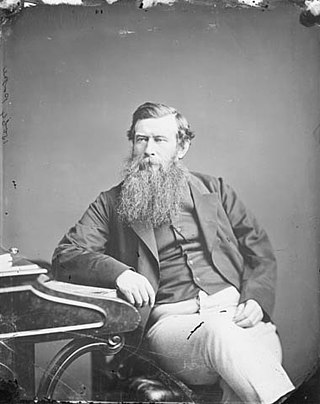
William Henry Pope was a Canadian lawyer, politician, journalist, judge and one of the Fathers of Confederation.

The Charlottetown Conference was held in Charlottetown, Prince Edward Island for representatives from colonies of British North America to discuss Canadian Confederation. The conference took place between September 1 through 9, 1864. The conference had been planned as a meeting of representatives from the Maritime colonies; Nova Scotia, New Brunswick and Prince Edward Island. Newfoundland agreed with the movement, but was not notified in time to take part in the proceedings. Britain encouraged a Maritime Union between these colonies, hoping that they would then become less economically and politically dependent on the Crown, and provide for greater economic and military power for the region in light of the American Civil War. However, another colony, the Province of Canada, comprising present-day Ontario and Québec, heard news of the planned conference and asked that the agenda be expanded to discuss a union that would also include them. In August 1864 Newfoundland also asked to be allowed to join the conference.

Stratford is a town located in Queens County, Prince Edward Island.

The Fathers of Confederation are the 36 people who attended at least one of the Charlottetown Conference of 1864, the Quebec Conference of 1864, and the London Conference of 1866, preceding Canadian Confederation. Only eleven people attended all three conferences.

Confederation Centre of the Arts is a cultural centre dedicated to the visual and performing arts located in the city of Charlottetown, Prince Edward Island, Canada.
The Charlottetown Festival is a seasonal Canadian musical theatre festival which runs from late May to mid-October every year since 1965.
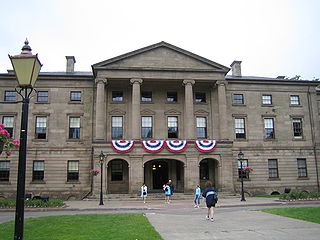
Province House is where the Prince Edward Island Legislature, known as the Legislative Assembly of Prince Edward Island, has met since 1847. The building is located at the intersection of Richmond and Great George Streets in Charlottetown; it is Canada's second-oldest seat of government.
The Charlottetown Driving Park (CDP), located in Charlottetown, Prince Edward Island, Canada is a harness racing track for racing standardbred horses.
Alberton is a Canadian town located in Prince County, Prince Edward Island. It is situated in the western part of the county in the township of Lot 5.
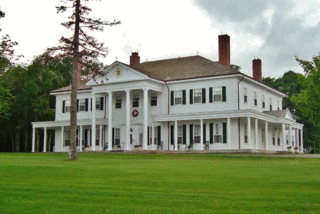
Government House of Prince Edward Island, often referred to as Fanningbank, is the official residence of the lieutenant governor of Prince Edward Island, as well as that in Charlottetown of the Canadian monarch. It stands in the provincial capital at 1 Terry Fox Drive; while the equivalent building in many provinces has a prominent, central place in the capital, the site of Prince Edward Island's Government House is relatively unobtrusive within Charlottetown, giving it more the character of a private home.

Dalvay-by-the-Sea is a National Historic Site of Canada located on the north shore of Prince Edward Island at the eastern end of Prince Edward Island National Park. The most significant feature of Dalvay is the Queen Anne Revival style hotel, originally constructed as a home for an American industrialist.

The history of Prince Edward Island covers several historical periods, from the pre-Columbian era to the present day. Prior to the arrival of Europeans, the island formed a part of Mi'kma'ki, the lands of the Mi'kmaq people. The island was first explored by Europeans in the 16th century. The French later laid claim over the entire Maritimes region, including Prince Edward Island in 1604. However, the French did not attempt to settle the island until 1720, with the establishment of the colony of Île Saint-Jean. After peninsular Acadia was captured by the British in 1710, an influx of Acadian migrants moved to areas still under French control, including Île Saint-Jean.
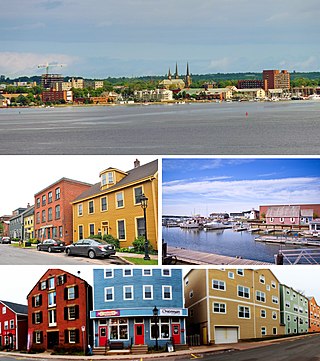
Charlottetown is the capital and largest city of the Canadian province of Prince Edward Island, and the county seat of Queens County. Named after Queen Charlotte, Charlottetown was an unincorporated town until it was incorporated as a city in 1855.
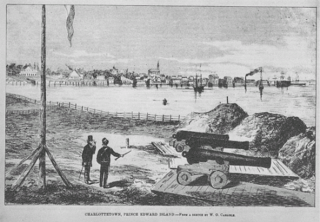
The History of Charlottetown can be traced back to the original French military settlement established on the site in 1720. Over the years Charlottetown has grown to become the largest and most important city on Prince Edward Island.
Brudenell was a municipality that held community status in Prince Edward Island, Canada. It was located along the Brudenell and Montague rivers.

The Confederation Centre Art Gallery is an art museum that forms a part of the Confederation Centre of the Arts in Charlottetown, Prince Edward Island, Canada. The art museum pavilion forms the northeast portion of the Confederation Centre of the Arts complex, and includes seven exhibition rooms that equal 3,250 square metres (35,000 sq ft) of space.
Victoria Row is a street mall in downtown Charlottetown, Prince Edward Island, in Canada. It is located on Richmond Street between Queen and Great George Streets. The architecture surrounding the cobblestone street dates back to the Victorian era, and is closed to vehicle traffic during the summer months. It is home to various boutique shops and restaurants and is considered a main tourist attraction in Charlottetown. The 'row' is located immediately due south of the Confederation Centre of the Arts on the west side, and the Province House on the east side, a national historic site. The Cameron Block, a prominent building known for its Italianate architecture style, is a part of Victoria Row.
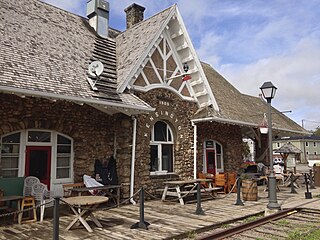
The Kensington Railway Station is a National Historic Site of Canada, located in the town of Kensington, Prince Edward Island. The train station was the third built at the site, and one of two "boulder stations" built by Charles Benjamin Chappell in 1904, so named for the fieldstone composing its exterior walls.














